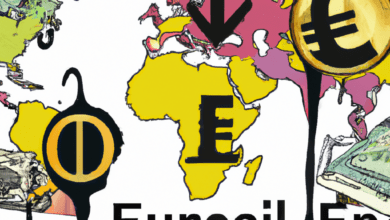The Role of Currencies in International Trade: Understanding Valuation, Trading Strategies, and the Future of Money

In an increasingly interconnected world, international trade serves as the lifeblood of global economies, heavily influenced by the dynamics of currencies. As nations engage in the exchange of goods and services, the valuation of currencies plays a pivotal role in determining trade balance and economic stability. This article delves into the intricate relationship between currencies and global trade, exploring the impact of central bank policies and forex trends on currency valuation. We will also examine effective currency trading strategies, including the navigation of currency pairs, hedging techniques, and opportunities for currency arbitrage in the ever-evolving global currency markets. Additionally, we’ll look ahead to the future of money by investigating the rise of cryptocurrencies, stablecoins, and Central Bank Digital Currencies (CBDCs) and their potential to revolutionize cross-border payments and trade practices. Whether you are a seasoned trader, a business owner, or just curious about how currencies affect international trade, this comprehensive exploration will equip you with valuable insights into the complex interplay of currencies in the global economy.
- 1. Understanding Currency Valuation: The Impact of Central Bank Policies and Forex Trends on International Trade
- 2. Currency Trading Strategies: Navigating Currency Pairs, Hedging, and Arbitrage in Global Markets
- 3. The Future of Money: Exploring Cryptocurrencies, Stablecoins, and CBDCs in Cross-Border Payments and Trade
1. Understanding Currency Valuation: The Impact of Central Bank Policies and Forex Trends on International Trade
Understanding currency valuation is crucial for grasping how central bank policies and forex trends influence international trade. Currency valuation refers to the worth of one currency in relation to another, impacting everything from import and export prices to the overall economic stability of nations involved in global trade.
Central bank policies play a pivotal role in determining currency value. When central banks, such as the Federal Reserve or the European Central Bank, adjust interest rates, they can influence inflation rates and, consequently, currency appreciation or depreciation. For instance, a rise in interest rates often leads to stronger fiat currencies, making exports more expensive and imports cheaper. This dynamic can significantly affect international trade balances.
Forex trends further complicate currency valuation. Traders in global currency markets buy and sell currency pairs based on market sentiment, economic indicators, and geopolitical events. This trading activity can create volatility, impacting emerging market currencies more acutely due to their susceptibility to capital flight and external shocks. Currency hedging becomes essential for businesses engaged in cross-border payments to mitigate risks associated with currency fluctuations.
Another aspect to consider is currency arbitrage, where traders exploit the price differences of currency pairs across different markets. This practice can lead to temporary currency fluctuations that impact international trade pricing strategies. As global trade evolves, the introduction of digital currencies, including stablecoins and Central Bank Digital Currencies (CBDCs), offers new avenues for currency conversion and cross-border transactions. These innovations could streamline payment processes and reduce costs, potentially reshaping international trade dynamics.
In recent years, currency trends have also been influenced by inflation and economic stability. Countries experiencing high inflation may see their currencies depreciate, leading to increased costs for imported goods and worsening trade deficits. Conversely, nations with stable currencies can attract foreign investment, bolstering their currency reserves and promoting healthier trade relationships.
Finally, currency futures and currency ETFs are tools that investors use to speculate on currency movements and hedge against potential losses. By strategically positioning themselves in the global currency markets, investors can ride trends in currency valuations while simultaneously supporting businesses involved in international trade.
As the landscape of currencies continues to evolve, understanding these factors is essential for businesses and investors looking to navigate the complexities of global trade effectively.
2. Currency Trading Strategies: Navigating Currency Pairs, Hedging, and Arbitrage in Global Markets
In the dynamic landscape of international trade, understanding currency trading strategies is crucial for businesses and investors alike. Currency trading, often referred to as forex trading, involves the buying and selling of currency pairs to capitalize on fluctuations in exchange rates. This section delves into key strategies, including navigating currency pairs, hedging, and arbitrage, that can help traders and businesses manage their exposure to currency risks.
Navigating currency pairs is a fundamental aspect of forex trading. Traders typically engage with major currency pairs, such as EUR/USD or USD/JPY, which represent the most traded currencies globally. Understanding the relationship between these currencies is essential for making informed decisions. For instance, a strong appreciation of the Euro against the Dollar could signal a favorable opportunity for European exporters, while a depreciation might raise concerns for U.S. importers.
Currency hedging is another critical strategy employed to mitigate potential losses from adverse currency movements. By using financial instruments like currency futures or options, businesses can lock in exchange rates, thereby protecting themselves from volatility. This is particularly important for companies involved in international trade, where fluctuations in currency values can significantly impact profit margins. For instance, if a U.S. business anticipates receiving payments in euros, hedging can help ensure that currency conversion does not lead to unexpected losses.
Another strategy worth noting is currency arbitrage, which takes advantage of price discrepancies in different markets. Traders can buy a currency in one market at a lower price and simultaneously sell it in another market at a higher price, thus profiting from the difference. This requires an acute awareness of global currency markets and swift execution, as these opportunities can vanish in seconds. As digital currencies and stablecoins gain traction, arbitrage opportunities may also emerge in the cryptocurrency space, providing new avenues for profit.
The interaction between central bank policies and currency trends cannot be overlooked. Central banks play a pivotal role in currency valuation, influencing interest rates and inflation, which in turn affect exchange rates. For example, a central bank's decision to lower interest rates may lead to currency depreciation, prompting traders to adjust their strategies accordingly. Moreover, with the rise of Central Bank Digital Currencies (CBDCs), the landscape of currency trading could witness significant changes, introducing new dynamics in currency conversion and cross-border payments.
Finally, emerging market currencies and fixed exchange rates present unique challenges and opportunities for traders. For instance, countries with currency pegs may experience stability but could also face currency wars if they manipulate their currency to gain a competitive edge in international trade. Understanding these nuances is vital for any trader looking to thrive in the complex world of global currency markets.
In conclusion, developing effective currency trading strategies involves a comprehensive understanding of currency pairs, hedging techniques, and arbitrage opportunities. By staying informed about market trends and central bank policies, traders can navigate the intricacies of international trade and optimize their currency strategies for success.
3. The Future of Money: Exploring Cryptocurrencies, Stablecoins, and CBDCs in Cross-Border Payments and Trade
The landscape of international trade is rapidly evolving, particularly with the emergence of digital currencies. As globalization continues to expand, understanding the future of money, including cryptocurrencies, stablecoins, and Central Bank Digital Currencies (CBDCs), becomes increasingly critical for traders, businesses, and policymakers.
Cryptocurrencies, like Bitcoin and Ethereum, have disrupted traditional notions of currencies, offering decentralized alternatives to fiat currencies. Their volatility, however, raises concerns about currency valuation and stability, making them less favorable for everyday cross-border payments. Despite this, the potential for cryptocurrencies in currency trading and currency arbitrage remains significant, as traders seek to capitalize on price fluctuations across different global currency markets.
Stablecoins, designed to minimize volatility by pegging their value to fiat currencies or commodities, present a more stable solution for international transactions. Their role in cross-border payments can enhance efficiency and reduce costs associated with currency conversion, making them attractive for businesses involved in international trade. Moreover, stablecoins can facilitate better currency hedging strategies, allowing companies to manage exposure to currency depreciation and appreciation during volatile market conditions.
Central Bank Digital Currencies (CBDCs) represent a significant shift in currency strategies for countries worldwide. By digitizing fiat currencies, central banks can streamline cross-border payments, improve transaction speeds, and reduce reliance on traditional banking systems. These digital currencies could potentially reshape global currency trends, impacting currency reserves and the dynamics of currency wars, particularly among emerging market currencies.
As central banks adopt CBDCs, they will need to navigate the intricacies of fixed exchange rates and currency pegs to maintain economic stability. The implications for international trade could be profound, as businesses adapt to new digital payment methods and the associated regulatory environments.
In summary, the future of money, characterized by cryptocurrencies, stablecoins, and CBDCs, is set to redefine the role of currencies in global trade. As these digital currencies gain traction, stakeholders must stay informed about currency futures, inflation impacts, and the evolving landscape of tourism and currencies to develop effective currency strategies for navigating the complexities of the global economy.
In conclusion, the role of currencies in international trade is multifaceted and continually evolving. Understanding currency valuation is crucial, as it significantly impacts trade dynamics influenced by central bank policies and forex trends. The strategic use of currency trading, including navigating currency pairs, hedging against risks, and leveraging arbitrage opportunities, enables businesses to mitigate potential losses and capitalize on market fluctuations.
As we look to the future, the emergence of digital currencies—such as cryptocurrencies, stablecoins, and Central Bank Digital Currencies (CBDCs)—promises to reshape cross-border payments and the global currency markets. These innovations offer new avenues for easing currency conversion and enhancing the efficiency of international trade.
However, challenges remain, including currency wars, inflation, and the complexities of managing emerging market currencies. As businesses adapt to these currency strategies, they must stay informed about currency trends and the implications of currency appreciation and depreciation on their operations.
Ultimately, a comprehensive understanding of international trade and the intricate web of currencies involved is essential for navigating today’s global economy. By leveraging insights from currency futures, currency ETFs, and the dynamics of fixed exchange rates and currency pegs, stakeholders can better position themselves to thrive in the ever-changing landscape of international commerce.
References:
– [Insert relevant sources here]





